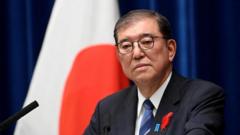Japanese voters are casting their ballots in a pivotal election on Sunday, marking a critical moment for Prime Minister Shigeru Ishiba as his coalition grapples with widespread public dissatisfaction over soaring prices and the looming threat of US tariffs. Facing a challenging landscape, the ruling Liberal Democratic Party (LDP) and their junior partner Komeito need to secure a total of 50 seats to maintain their majority in the upper house. However, recent polling indicates they may struggle to achieve this target.
The timing of this election is particularly precarious for Ishiba. Ongoing tariff negotiations led by US President Donald Trump have intensified pressure on Tokyo, significantly impacting Japan's massive auto industry, which employs around 8% of the nation's workforce. Weak export data released last week has further fueled concerns that Japan may slip into a technical recession.
In light of steep price increases, particularly in food staples like rice—whose cost has almost doubled since last year—Japanese households find themselves increasingly burdened by inflation. The government has had to resort to its emergency stockpiles to address food shortages, reflecting the urgency of rising costs for voters.
Since the lower house election last year, which saw the LDP's coalition lose its majority, trust in the government appears to have eroded, with stagnant wages contributing to growing discontent. Complicating matters is the emergence of the populist Sanseito party, which has gained traction through social media campaigns appealing to younger voters. Their "Japanese First" messaging resonates with some conservatives, though their hardline views on immigration and opposition to globalism have sparked controversy.
If Ishiba's coalition fails to secure the necessary seats, it risks losing its majority across both chambers of parliament, potentially jeopardizing his leadership and triggering political instability. The LDP and Komeito have held power in Japan almost uninterrupted since 1955, albeit with numerous leadership changes. The last time the coalition did not achieve a majority in the upper house was in 2010, after which a significant shift occurred in government leadership.
As the election results unfold, the implications for Japan's political future could be profound, setting the stage for new dynamics in governance and policy-making.




















